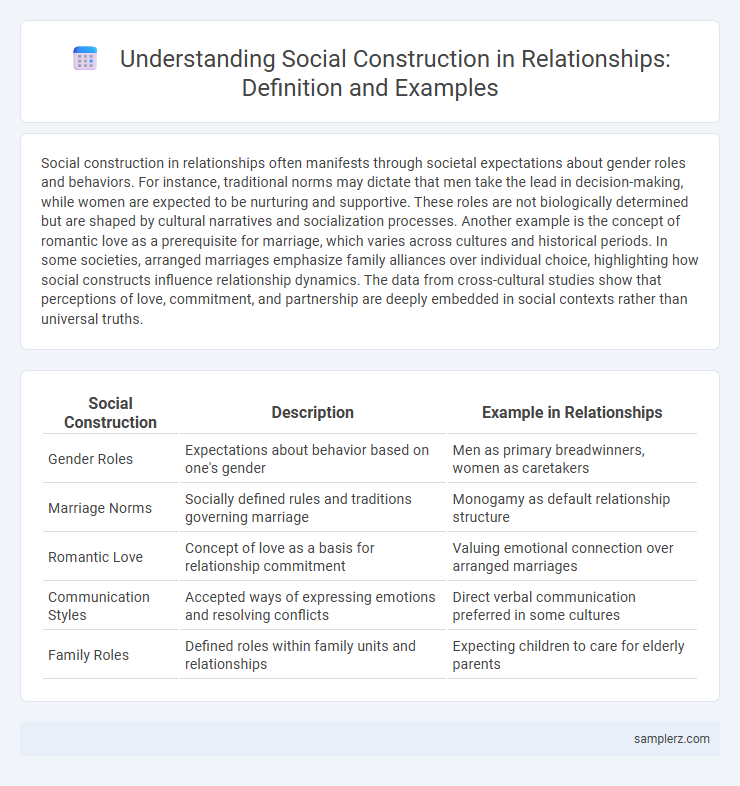Social construction in relationships often manifests through societal expectations about gender roles and behaviors. For instance, traditional norms may dictate that men take the lead in decision-making, while women are expected to be nurturing and supportive. These roles are not biologically determined but are shaped by cultural narratives and socialization processes. Another example is the concept of romantic love as a prerequisite for marriage, which varies across cultures and historical periods. In some societies, arranged marriages emphasize family alliances over individual choice, highlighting how social constructs influence relationship dynamics. The data from cross-cultural studies show that perceptions of love, commitment, and partnership are deeply embedded in social contexts rather than universal truths.
Table of Comparison
| Social Construction | Description | Example in Relationships |
|---|---|---|
| Gender Roles | Expectations about behavior based on one's gender | Men as primary breadwinners, women as caretakers |
| Marriage Norms | Socially defined rules and traditions governing marriage | Monogamy as default relationship structure |
| Romantic Love | Concept of love as a basis for relationship commitment | Valuing emotional connection over arranged marriages |
| Communication Styles | Accepted ways of expressing emotions and resolving conflicts | Direct verbal communication preferred in some cultures |
| Family Roles | Defined roles within family units and relationships | Expecting children to care for elderly parents |
Defining Social Construction in Relationships
Social construction in relationships refers to the understanding that relationship roles, norms, and expectations are created and maintained through cultural and societal influences rather than being innate. Concepts such as gender roles, communication patterns, and the meaning of commitment are shaped by social interactions and shared beliefs within a community. These constructions vary across cultures and historical periods, highlighting that relationship dynamics are fluid and socially negotiated.
The Role of Cultural Norms in Romantic Partnerships
Cultural norms profoundly influence romantic partnerships by shaping expectations around gender roles, communication styles, and expressions of love. In many societies, these socially constructed guidelines dictate acceptable behaviors, such as who initiates courtship or how affection is publicly displayed, reinforcing shared values and identity within the relationship. This framework highlights how cultural context continuously molds the dynamics and sustainability of romantic connections.
Gender Roles and Expectations in Dating
Gender roles and expectations in dating often shape behaviors and communication patterns between partners, reinforcing societal norms about masculinity and femininity. Men are frequently expected to initiate dates and exhibit assertiveness, while women are socially conditioned to display nurturing and passive qualities. These constructed roles influence relationship dynamics, sometimes limiting individual expression and perpetuating stereotypes within social interactions.
Marriage: A Socially Constructed Institution
Marriage exemplifies a social construction shaped by cultural norms, legal frameworks, and historical contexts. The institution establishes roles, rights, and responsibilities that vary across societies, reflecting collective beliefs rather than innate biological factors. Changing attitudes toward marriage, such as acceptance of same-sex unions, highlight its fluid and evolving nature as a social construct.
Family Structures: Traditions Versus Modernity
Family structures exemplify social construction through evolving traditions that influence roles, expectations, and relationships among members. Variations include nuclear, extended, single-parent, and blended families, reflecting cultural shifts and societal norms. Modernity challenges traditional patriarchal hierarchies, promoting egalitarian and diverse family models shaped by changing values and legal frameworks.
The Influence of Media on Relationship Ideals
Media shapes relationship ideals by consistently portraying romantic partnerships through curated narratives that emphasize perfection, passion, and traditional gender roles, influencing societal expectations. These portrayals reinforce social constructs, guiding individuals on how to perceive and engage in relationships based on mediated standards rather than personal experience. Exposure to idealized relationship models in television, movies, and social media platforms alters perceptions of love, commitment, and communication norms within couples.
Social Class Impact on Relationship Dynamics
Social class profoundly shapes relationship dynamics by influencing communication patterns, expectations, and conflict resolution styles between partners. Studies reveal that couples from differing social classes often face challenges related to financial management and social norms, which can lead to increased tension or misunderstandings. These class-based disparities impact emotional intimacy and power balance, highlighting how socio-economic status functions as a critical social construct within relationships.
Friendship Boundaries and Social Conventions
Friendship boundaries are social constructs shaped by cultural norms and individual expectations, defining acceptable behaviors and emotional intimacy levels between friends. Social conventions dictate how people navigate privacy, communication frequency, and mutual obligations within friendships, ensuring comfort and respect. These boundaries evolve based on societal values, reinforcing trust and preventing conflicts in social interactions.
Emotional Expression: Social Construction in Couples
Emotional expression in couples is shaped by social norms and cultural expectations that dictate which feelings are appropriate to display and how they should be communicated. Gender roles often influence emotional openness, with men traditionally encouraged to suppress vulnerability while women are socialized to express empathy and care. These socially constructed patterns impact relational dynamics, emotional intimacy, and conflict resolution within partnerships.
Communication Styles Shaped by Society
Communication styles in relationships are social constructs influenced by cultural norms, gender roles, and societal expectations. For instance, expressive communication is often encouraged in women, while men may be socialized to adopt more reserved or assertive styles. These socially shaped communication patterns impact how partners express emotions, resolve conflicts, and build intimacy.

example of social construction in relationship Infographic
 samplerz.com
samplerz.com